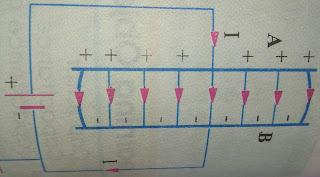Electric Field theory:-
It is found that in the medium around a charge a force acts on a positive or negative charges when placed in that medium. If the charge is sufficiently large, then it may create such a huge stress as to cause the electrical rupture of the medium, followed by the passage of an arc discharge.
 |
| Attraction |
The region in which the stress exists or in which electric forces act, is called an Electric Field or Electrostatic field.
The stress is represented by imaginary lines of forces. The direction of the lines of force at any point is the direction along which a unit positive charge placed at that point would move if free to do so.
It was suggested by Faraday that the electric field should be imagined to be divided into tubes of force containing a fixed number of lines of force.
 |
| Electric field repulsion |
He assumed these tubes to the elastic and having the property of contracting longitudinally the repelling laterally. With the help of these properties ,it becomes easy to explain .....
1) why unlike charges attract each other and try to come nearer to each other
2)why like charges repel each other.
However it is more common to use the term lines of force.
These lines are supposed to emanate from a positive charge and end on a negative charge .these lines always leave or enter a conducting surface normally.
You may Read....👇
What is Static Electricity (Electrostatics)
👍👍👍👍👍👍👍👍





